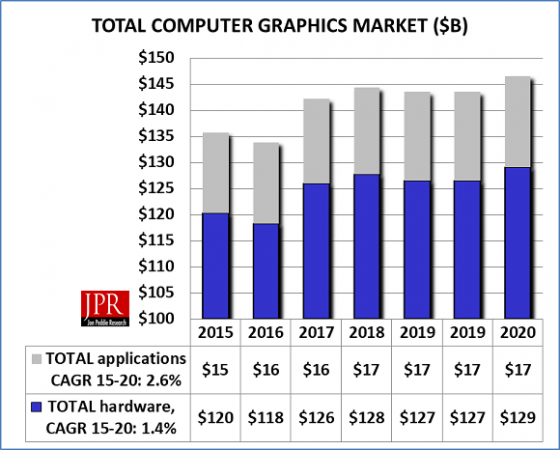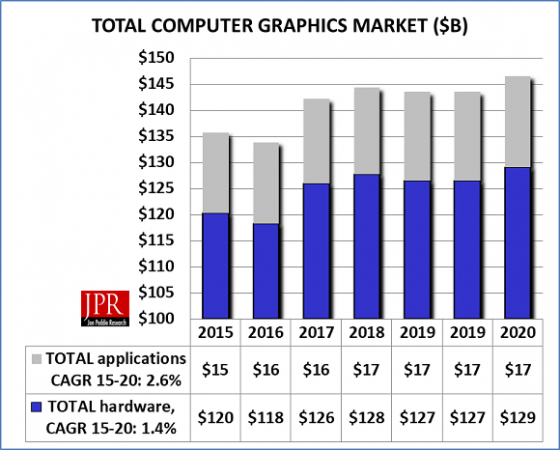Details from this annual report will be shared at the JPR Press Luncheon at Siggraph.
Jon Peddie Research (JPR) has released its annual market report for the computer graphics industry. The computer graphics hardware market was worth $118 billion in 2015 and is expected to drop to $112 billion by 2019, with software growing slightly better than hardware.
Ever since it came into being during 1970s, the computer graphics (CG) industry has been a mixed bag of technologies, users, and applications, and has had for the most part a consistent (and lumpy) growth record. The growth, largely influenced by hardware, has slowed in the past couple of years and will be low to slow going forward — but growth nonetheless.
The chart below shows the growth in hardware and software. The software aspects of the market have been slow to flat, while the hardware segments have been varied, influenced by consumer products such as game consoles. Virtual reality, which has gained so much attention, is hardly a factor in either hardware or software, and despite some glowing forecasts, we don’t think it will be for a while. The main point of exploration for VR today is in content creation and design for professionals.

The hardware segment of the CG industry has seen steady overall growth, with some ups and downs due to product cycles and the irregularity of the PC market. The largest growth has been in game consoles, gaming PCs, and workstations, with the mobile graphics segment declining due to fewer units being sold and dropping ASPs as the suppliers compete in a rapidly shifting market. 2016 saw the introduction of new GPUs and add-in boards (AIBs), CPUs, and game consoles.
The market for CG software in 2016 was worth $15.5 billion (not counting services, maintenance and other aspects) and is expected to grow to $17.5 billion by 2020 as the industry shifts its sales model moving more services to the cloud, and transitioning to a subscriber system.
We will see the development of traditional segments like CAD/CAM expand as new design approaches in automotive, aerospace, and architecture are adopted. The visualization market is growing due to the availability of more powerful and less expensive visualization technologies and also as more customers add design analysis to their portfolio. GPU compute employing OpenCL and CUDA is penetrating further into new industries as well as traditional applications.
The software content creation market has been tough for the market leaders. They’re living with a mature market with little growth, but stability among the competitors. In other words, if everything stays the same, there’s not much opportunity for growth. However, new opportunities are emerging as new approaches to content creation become practical, new distribution channels open up, and young generations arrive with a new fascination for 3D.
The demand for programmers, artists, scientists, and designers continues to be strong and we’re seeing startups arrive in emerging and reborn markets such as augmented reality, virtual reality, and casual games. The arrival of new APIs and platforms are also stimulating development. Firms are actively looking for people who can use and exploit these new programs and their associated hardware accelerators.
New opportunities are also growing out of mainstream applications for the web and consumer applications. The social web remains a strong engine for growth. Social networks are encouraging people to learn new tools, create content for pleasure, and even look for jobs in the field. What used to be a very closed society of experts is now opening up due to the democratization of CG, fueled by Moore’s law and price-elasticity due to lower software costs. We believe a new generation of 3D creators is being born as 3D tools become more accessible. Early examples include the Creative edition of Windows, Adobe’s Project Felix, variations on Nvidia’s iRay, and developments using Chaos Group’s V-Ray AppSDK.
Cloud-based creation tools have been a bit of a disappointment: those designed to be easy are usually not easy enough and the results are unsatisfactory and professional tools are also not designed for the creatives, but for engineers.
However, attractive pricing models are emerging, the tools will adapt so, we do see an interesting future for 3D content creation.
Given the trends in dropping costs, and the increasing users and usage of CG tools and hardware, we predict that the rate of growth for the CG industry will remain fairly steady for the foreseeable future. Computer graphics is truly a worldwide industry now. JPR will have a press only discussion on this topic at SIGGRAPH at the JW Marriott Live LA, on the 2nd of August at noon – all press are invited.
About Jon Peddie Research
Dr. Jon Peddie has been active in the graphics and multimedia fields for more than 30 years. Jon Peddie Research is a technically oriented multimedia and graphics research and consulting firm. Based in Tiburon, California, JPR provides consulting, research, and other specialized services to technology companies in a variety of fields including graphics development, multimedia for professional applications and consumer electronics, high-end computing, and Internet-access product development. Jon Peddie’s Market Watch is a quarterly report focused on the market activity of PC graphics controllers for notebook and desktop computing.








